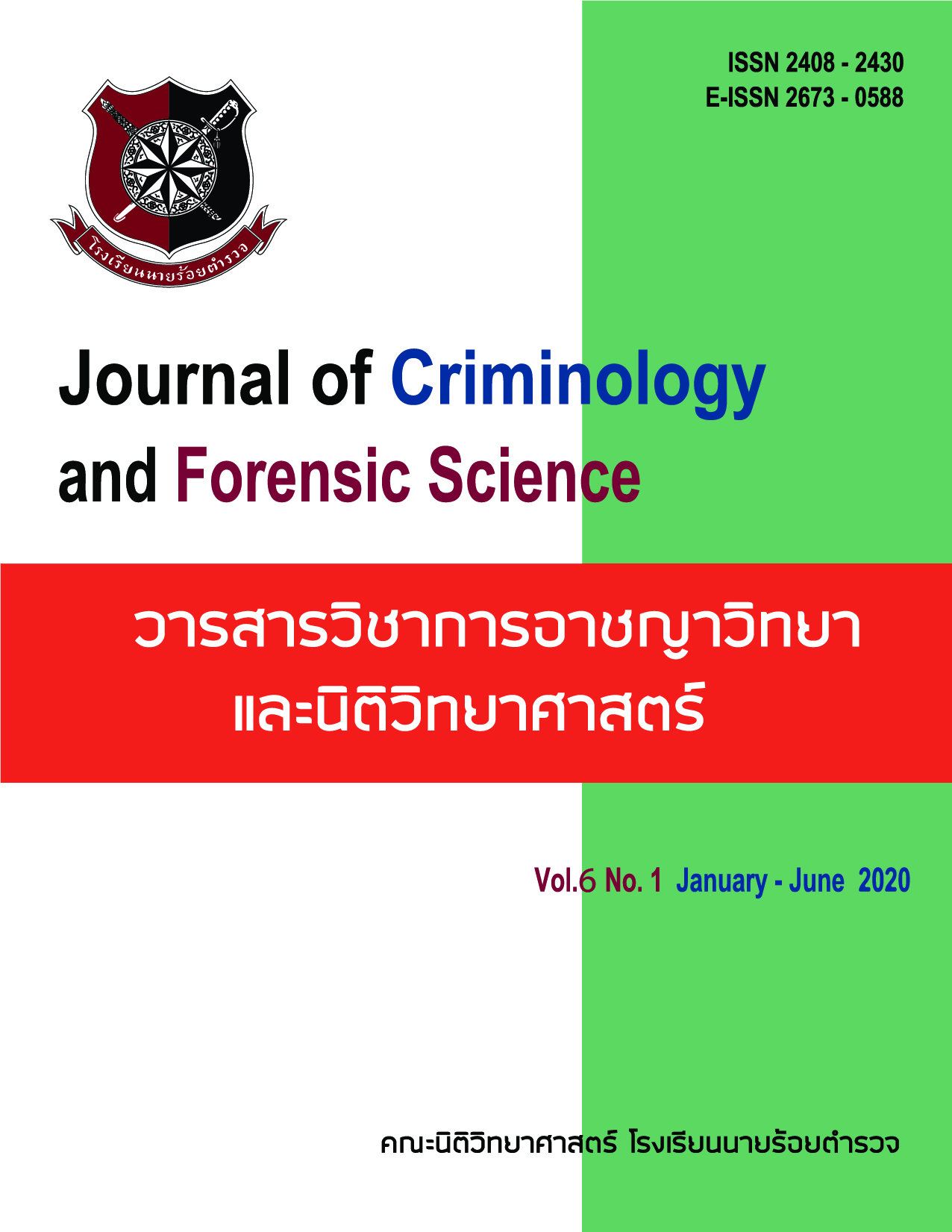การรับรู้ความเสี่ยงต่อพฤติกรรมที่ก่อให้เกิดอาชญากรรมทางเทคโนโลยี กรณีศึกษาโมบายแบงก์กิ้ง
Main Article Content
บทคัดย่อ
งานวิจัยนี้มีวัตถุประสงค์เพื่อศึกษาความสัมพันธ์ของคุณลักษณะส่วนบุคคลประกอบด้วย เพศ อายุ ระดับการศึกษา อาชีพ รายได้ ความถี่ในการใช้งานระบบโมบายแบงก์กิ้ง และจำนวนบัญชีผู้เปิดใช้ระบบโมบายแบงก์กิ้ง ที่มีผลต่อพฤติกรรมการรับรู้ความเสี่ยงที่ก่อให้เกิดอาชญากรรมบนระบบโมบายแบงก์กิ้ง โดยใช้แบบสอบถามเป็นเครื่องมือในการเก็บข้อมูลจากกลุ่มตัวอย่างที่มีอายุตั้งแต่ 15 ปีขึ้นไป และมีบัญชีธนาคารเป็นของตนเองจำนวน 418 คน จากนั้นนำข้อมูลมาวิเคราะห์ทางสถิติ โดยใช้การวิเคราะห์ความแปรปรวนทางเดียว และการทดสอบไคสแคว์
ผลการวิจัยพบว่า ผู้ใช้บริการระบบโมบายแบงก์กิ้งมีการรับรู้ความเสี่ยงอยู่ในระดับปานกลาง โดยการรับรู้ความเสี่ยงด้านความปลอดภัยมีระดับการรับรู้สูงที่สุด และพบว่าความสัมพันธ์ระหว่างปัจจัยการรับรู้ความเสี่ยงต่อคุณลักษณะส่วนบุคคลด้านเพศของผู้ใช้บริการระบบโมบายแบงก์กิ้งไม่มีความสัมพันธ์กับปัจจัยการรับรู้ความเสี่ยงทุกด้าน ในทางกลับกันอายุ ระดับการศึกษา อาชีพ รายได้ ความถี่ในการใช้ระบบโมบายแบงก์กิ้ง และจำนวนบัญชีผู้เปิดใช้ระบบโมบายแบงก์กิ้ง มีความสัมพันธ์กับปัจจัยการรับรู้ความเสี่ยงทุกด้าน
คุณลักษณะส่วนบุคคลด้าน อายุ ระดับการศึกษา อาชีพ รายได้ ความถี่ในการใช้ระบบโมบายแบงก์กิ้ง และจำนวนบัญชีผู้เปิดใช้ระบบโมบายแบงก์กิ้ง มีผลกระทบอย่างมีนัยสำคัญต่อการรับรู้ที่ก่อให้เกิดอาชญากรรมบนระบบโมบายแบงก์กิ้งแตกต่างกันทุกด้าน ส่วนเพศมีผลต่อการรับรู้ที่ก่อให้เกิดอาชญากรรมบนระบบโมบายแบงก์กิ้งแตกต่างกันเฉพาะด้านความปลอดภัย ด้านประสิทธิภาพ ด้านการเงิน ด้านสังคมและจิตใจ และด้านเวลาเท่านั้น
Article Details
เนื้อหาและข้อมูลในบทความที่ลงตีพิมพ์ใน วารสารวิชาการอาชญาวิทยาและนิติวิทยาศาสตร์ โรงเรียนนายร้อยตำรวจ ถิอว่าเป็นข้อคิดเห็นและความรั้บผิดชอบของผู้เขียนบทความโดยตรงซึ่งกองบรรณาธิการวารสาร ไม่จำเป็นต้องเห็นด้วยหรือรับผิดชอบใดๆ
บทความ ข้อมูล เนื้อหา รูปภาพ ฯลฯ ที่ได้รับการตีพิมพ์ใน วารสารวิชาการอาชญาวิทยาและนิติวิทยาศาสตร์ ถือว่าเป็นลิขสิทธิ์ของวารสาร วารสารวิชาการอาชญาวิทยาและนิติวิทยาศาสตร์ หากบุคคลหรือหน่วยงานใดต้องการนำทั้งหมดหรือส่วนหนึ่งส่วนใดไปเผยแพร่ต่อหรือเพื่อกระทำการใดๆ จะต้องได้รับอนุญาตเป็นลายลักษณ์อักษรจาก วารสารวิชาการอาชญาวิทยาและนิติวิทยาศาสตร์ ก่อนเท่านั้น
เอกสารอ้างอิง
Bank of Thailand. (2018). Payment Transactions Via Mobile Banking and Internet Banking Services. Retrieved January 17, 2019. from http://www2.bot.or.th. (In Thai).
Bregant, J., and Bregant, R. (2014). Cybercrime and Computer Crime. The Encyclopedia of Criminology and Criminal Justice. Hoboken: Blackwell Publishing Ltd.
Davis, F. (1989). Perceived Usefulness, Perceived Ease of Use, and User Acceptance of Information Technology. MIS Quarterly, 13(3), 319-339.
Digital Business Consult. (2018). 5 Ways to Protect Your Business from Cyberattacks. Retrieved January 18, 2019. from https://www.digitalbusinessconsult.asia/view/1068. (In Thai).
Joseph, S. J. (2019). E-Commerce: An Indian Perspective. (23). Delhi, India: PHI Learning Private Limited.
Maciejewski, G. (2011). The Meaning of Perceived Risk in Purchasing Decisions of the Polish Customers. Scientific Annals of the Alexandru Ioan Cuza University of Iasi Economic Sciences, 58(1), 280-304.
Office of National Higher Education Science Research and Innovation Policy Council. (2019). IT-T003 Trends of Fixed Line Telephone Mobile Telephone and Internet Use in Thailand, 2010 – 2018. Retrieved September 25, 2018. from http://stiic.sti.or.th/stat/ind-it/it-t003. (In Thai).
Pimpasarn, P. (2012). Customer’s Risk Perception of Internet Banking Case Study: Krung Thai Bank Public Company Limited in Kalasin Branch. Master of Economic Independent Study, Khon Kaen University, Khon Kaen. (In Thai).
Shuhidan, S. M., Hamidi, S. M., and Saleh, I. S. (2017). Perceived Risk Towards Mobile Banking: A Case Study of Malaysia Young Adulthood. IOP Conference Series: Materials Science and Engineering, 226. 1-7.
World Trade Organization. (2017). E-Commerce. Retrieved September 16, 2018.from https://www.wto.org/english/thewto_e/minist_e/mc11_e/briefing_notes_e/bfecom_e.htm.
Yamane, T. (1973). Statistics: An Introductory Analysis. 3rd Edition. New York: Harper & Row.


